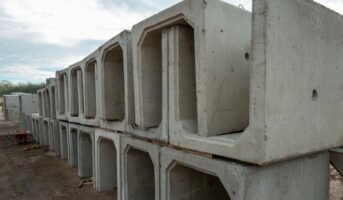A manhole cover is a heavy, secure lid placed over a manhole entrance to prevent unwanted access to the hole. Manhole cover design and installation are intricate procedures that need in-depth understanding. Here, you’ll learn more about the many kinds of manhole covers and how to choose the one that’s best for your situation.
Importance of manholes
Manholes are often used to join many pipes, such as those used for water distribution or sewage removal. The primary function of a manhole is to facilitate repair and maintenance. Pipes and tunnels run under today’s city streets and sidewalks to connect the various drainage systems. The size and orientation of the manhole’s opening must be customised for each use.
What is a manhole cover?
A manhole cover, sometimes called a maintenance hole cover, is a detachable plate that serves as the lid over the entrance of a manhole. Manholes are used to get access to subterranean vaults or pipes and are big enough for a human to go through. Its purpose is to keep out unwanted visitors and their items, as well as to stop anything or anybody from falling in.
For protection against ground pressure, most manholes are spherical, however square or rectangular manholes are sometimes installed so that larger machines can more easily reach the utilities. Unexpectedly intriguing and technical considerations like geometry, usefulness, safety, and economics go into designing manhole covers.
Why are the majority of the manhole covers round/ circular?

Source: Pinterest
There is some flexibility in the design of a manhole cover; some common examples include rectangles, squares, and circles. However, the round manhole that is so widespread is the top pick. Since most manholes are shaped like circles, it stands to reason that their covers would also be round.
- A round manhole cover cannot fall through its circular aperture; however, a square manhole cover fitted diagonally into the hole could very well fall in.
- Round tubes are the most durable and material-efficient form against the earth’s compressive force.
- A round manhole cover of a particular diameter has a smaller surface area than a square manhole cover of the same width; hence, less material is required to cast the manhole cover, resulting in a reduced price.
- Covers with a circular opening can be placed directly over the manhole without any angling or rotation.
- The portability of a circular manhole cover is enhanced by its ability to be rolled.
- Manhole frames and coverings have their bearing surfaces machined to ensure flatness and prevent traffic from dislodging them.
Types of manhole covers
Cast iron, concrete, or a hybrid of the two materials were formerly the norm when it came to the construction of manhole covers. Due to their long lifespan, low cost, and substantial weight, these materials are highly favoured. But modern technology has allowed for many more options for manhole covers, such as composite, fibreglass, and plastic.
-
Ductless Iron
Ductile iron (SG iron) or nodular iron, a special kind of iron, is often used to make these manhole covers. The modularity of the ore is a key factor in establishing the iron’s quality. Covers made of ductile iron are renowned for their durability, sturdiness, and strength. Due to the anti-rust asphalt paint sprayed by manhole cover manufacturers, ductile iron will not corrode as rapidly as cast iron.
-
Recessed
These manhole covers are often put in recessed locations that can accommodate block paving, cement, and a screed layer for aesthetically pleasing finishes on pedestrian walkways. Internal manhole covers at hospitals, cast iron manufacturing facilities, residential neighbourhoods, apartment complexes, and private backyards may all benefit from this approach. There are rules governing the weight capacities of recessed coverings.
-
Front and Corner Solid
These manhole covers stand out from the ground for easy identification. The solid silver top manhole cover is composed of galvanised steel, which is both lightweight and anti-slip. It is common practice to set them up in places that get frequent attention from maintenance and safety personnel. For less rigorous activities, you can find it more convenient to use a solid top cover with inset grab grips that fit flush to the floor. Covers with a solid top are regulated by load class restrictions. Exporters of manhole covers comply with loading class restrictions, so their products are sold internationally.
Materials used for manhole covers
Manhole covers may seem easy, but there are really a lot of moving parts involved in making them. Manhole covers are constructed from various materials depending on their function and the kind of manhole they are meant to cover.
-
Ingot Iron
Ductile and cast iron, two of the hardest and most durable metals known, have been used to make manhole covers for ages. This kind of sewer cover is often installed in high-traffic locations like highways due to its capabilities to withstand severe loads. Manhole covers made of ductile or cast iron can support up to 90 tonnes of pressure; they are often installed over larger shafts.
-
Plastic
Polyethene material (plastic) manhole covers are regarded to be long-lasting since they resist corrosion and deterioration. Manhole covers made of plastic do not corrode and release harmful substances into the ground. As a result, they last a long time with only occasional replacement. Plastic coverings tend to stay longer, but they can only support low weights. Thus they are often used in pedestrian areas like gardens and sidewalks.
-
Steel
Manhole covers are often installed in pedestrian areas such as driveways, and pathways and are fabricated from heavy-duty steel to withstand considerable foot traffic. These covers are constructed and galvanised from steel for best usage.
-
Composite
Composite manhole covers are constructed using state-of-the-art fibreglass reinforced plastic components, making them incredibly lightweight and simple to handle despite their higher strength and product longevity. Since this lowers the likelihood of harm occurring during installation, it leads to less dangerous working conditions overall. Composite manhole covers can be placed in the most extreme situations due to the material’s resistance to corrosion and conductivity. These sewage covers are suitable for both light- and medium-traffic areas, making them ideal for sidewalks and streets.
How to choose the right manhole cover?

Source: Pinterest
There is a wide range of factors to take into consideration while selecting a manhole cover and frame. It is essential to choose a budget beforehand and take accurate measurements of the entrance of your manhole to locate a manhole cover that will sit securely atop the shaft.
-
Price
The price of a manhole cover is greatly influenced by both the quality of the cover and the materials that are used to make it. Plastic and fibreglass, for instance, are examples of very affordable materials that provide a variety of advantages, but they are not able to handle greater weight loads. Despite this, manhole covers of acceptable quality can be availed at reasonable costs, although this will depend on the size and scope of the project.
-
Narrow down on the dimensions
Obtaining the manhole cover’s measurements is step one if you need to replace the one you have. In addition to the length, breadth, and depth, knowing the weight might be helpful.
Whether you’re working with a circle or a rectangle, consistency in shape is essential. Considering that not all businesses work with the same sizing units, you should take measurements in both inches and millimetres.
It should be noted that the dimensions of the manhole cover are identical to those of the opening in the manhole cover. Although the dimensions can remain the same after installation, the frame must be taken into account. For instance, if the inside diameter of a circular manhole cover is 24 inches and the inside depth is 18 inches, the resulting measurements with the frame will be 24 inches in diameter and 20 inches in depth.
-
Find what will be covering it
What will be placed on top of this manhole cover is the next item on your agenda. Is it going to be a group of people, a vehicle, or an in-betweener like a lawnmower? From this, you might learn what materials are most suited for its construction.
Cast iron is the most popular choice since it can withstand the greatest weight, although polypropylene coverings can also withstand the weight of most automobiles in a driveway. Galvanised steel or other lightweight plastic versions can be used if just humans will be treading on the cover.
-
Determine the total amount of water that will pass through
Finding out how much water passes through the region is crucial when deciding which manhole cover to use for your project. A grated manhole cover might be a wise investment if clogs are a common occurrence on your property.
However, knowing the extent to which your property might get clogged can be difficult. If you are doubtful, you should wait till the next time it rains and then checks your backyard for signs of backup. If so, then you know what kind of manhole cover to acquire.
-
Aesthetic considerations
The replacement cover you choose should better complement your landscape, which is why you’re considering it in the first place. Indeed, a manhole cover will never seem completely natural, but by experimenting with different materials and paint jobs, you can make it look less out of place.
For the very particular, nevertheless, there is the option of recessed manhole covers, which provide an additional 60 mm of space on top. There’s a good chance you won’t be able to plant anything in there, but if it’s going in your driveway, you can always fill it with soil or even asphalt. There is no limit to the possibilities.
FAQs
Why are manhole covers fashioned like a circle?
Consequently, many manhole covers are circular so that they do not need to be turned. Additionally, a circular manhole cover will not fall into a hole if it is spun in the incorrect direction, making it safer.
How much do manhole covers weigh, on average?
Manhole coverings typically weigh something in the range of 100 kg to 150 kg.
What are the many varieties of manhole covers that are available in India?
There are several varieties of manhole covers that can be constructed from a broad range of materials, such as concrete, cast iron, composites, fibreglass, and plastic. Lightweight drain covers are often made of plastic, fibreglass, or composite material.
Housing News Desk is the news desk of leading online real estate portal, Housing.com. Housing News Desk focuses on a variety of topics such as real estate laws, taxes, current news, property trends, home loans, rentals, décor, green homes, home improvement, etc. The main objective of the news desk, is to cover the real estate sector from the perspective of providing information that is useful to the end-user.
Facebook: https://www.facebook.com/housing.com/
Twitter: https://twitter.com/Housing
Email: [email protected]











